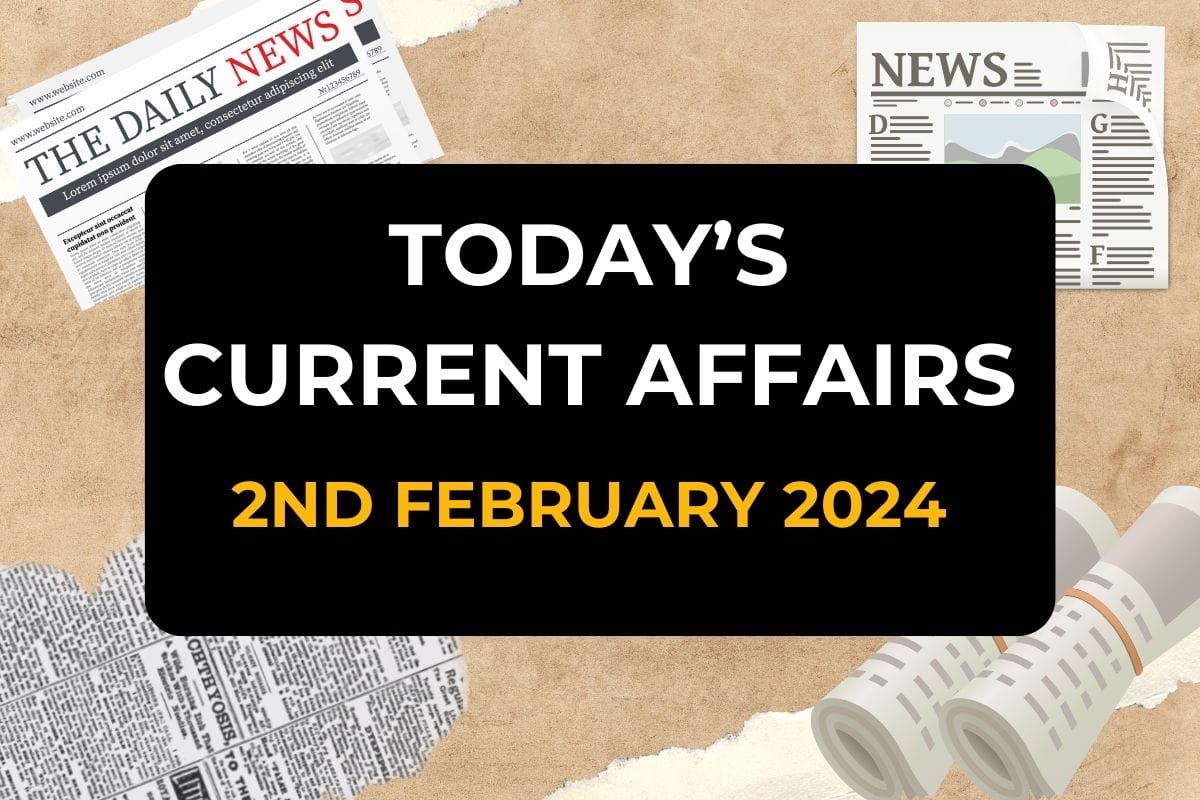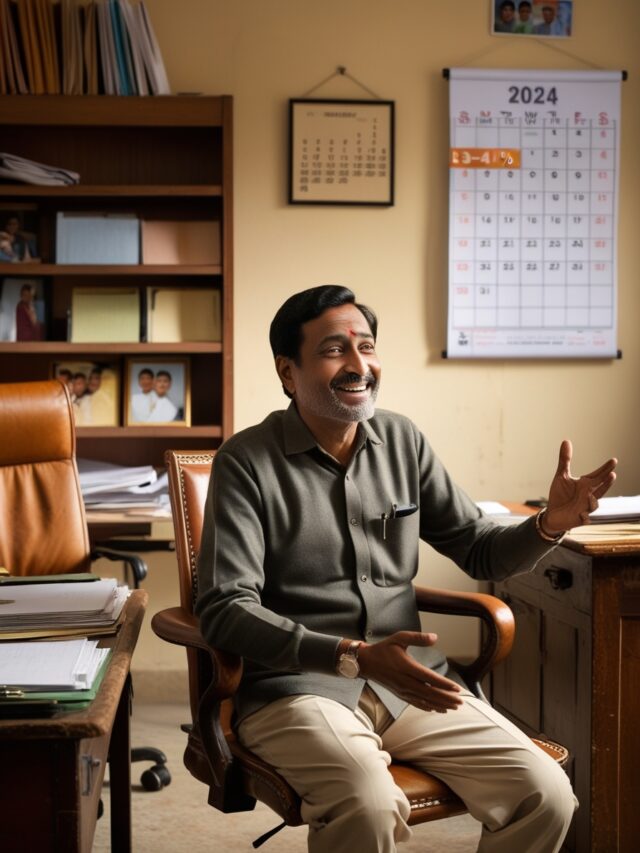
These current affairs today are a part of our daily current affairs series. We cover a wide range of topics from state, national, and international news that are relevant and important for competitive exams. Our team prepares daily current affairs after going through many newspapers, such as The Hindu, Indian Express, PIB, PRS, etc.
Scroll down for daily current affairs for 2 February 2024.
Budget 2024: No Change In Income Tax Slabs
Finance Minister Nirmala Sitharaman while presenting Interim Budget 2024 on 1 February 2024, kept the tax slab rates unchanged for both new and old income tax regimes.
The average time for processing income tax returns has reduced from 93 days in 2013-2014 to 10 days in the current financial year.
New regime tax slabs
No tax would be levied for income up to ₹3 lakh per year.
-Income between ₹3-6 lakh would be taxed at 5 per cent (tax rebate under Section 87A is available)
-Income between ₹6-9 lakh would be taxed at 10 per cent (tax rebate under Section 87A on income up to ₹7 lakh is available)
-Income between ₹9-12 lakh at 15 per cent
-Income between ₹12-15 lakh at 20 per cent
-Income of ₹15 lakh and above will be taxed at 30 per cent.
The tax rates in the new tax regime are the same for all categories of Individuals, i.e. Individuals, Senior citizens, and Super senior citizens.
Old regime tax slabs
Income up to ₹2.5 is exempt from taxation under the old tax regime.
-Income between Rs 2.5 to Rs 5 lakh would be taxed at 5 per cent.
-Income between Rs 5 to Rs 10 lakh would be taxed at 20 per cent.
-Income of Rs 10 lakh and above will be taxed at 30 per cent.
Allocation for some ministries in Budget 2024-25
- In the 2024-25 Interim Budget, India’s capital spending sees an 11% increase to ₹11.11 lakh crore, equivalent to 3.4% of the GDP. The highest allocation goes to the Defence Ministry, receiving ₹6.1 lakh crore.
- Other notable allocations include ₹2.78 lakh crore for the Ministry of Road Transport and Highways, ₹2.55 lakh crore for the Ministry of Railways, ₹2.13 lakh crore for the Ministry of Consumer Affairs, Food & Public Distribution, ₹2.03 lakh crore for the Ministry of Home Affairs, ₹1.77 lakh crore for the Ministry of Rural Development, ₹1.68 lakh crore for the Ministry of Chemicals and Fertilizers, ₹1.37 lakh crore for the Ministry of Communications, and ₹1.27 lakh crore for the Ministry of Agriculture and Farmer’s Welfare.
- In terms of major schemes, the government allocates ₹786,000 crore for the Mahatma Gandhi National Rural Employment Guarantee Scheme, ₹7,500 crore for Ayushman Bharat-PMJAY, and ₹6,200 crore for the Production Linked Incentive Scheme in the Interim Budget.
- Additionally, allocations include ₹6,903 crore for the Modified Programme for Development of Semiconductors and Display Manufacturing Ecosystem and ₹8,500 crore for Solar Power (Grid). The Defence Ministry receives an allocation of ₹6.1 lakh crore in the interim budget for 2024-25.
Lakhpati Didi scheme: Enhancing target to 3 crore from 2 crore
- In her 2024 budget speech, Union Finance Minister Nirmala Sitharaman announced the government’s intention to increase the Lakhpati Didi target from 2 crore to 3 crore.
- The term ‘Lakhpati Didis’ refers to women members of Self Help Groups (SHGs) utilizing their entrepreneurial skills to earn a sustainable income of at least Rs 1 lakh per year per household. The scheme is designed to promote economic independence and women’s empowerment.
- Prime Minister Narendra Modi initially introduced the scheme during his Independence Day speech on August 15, 2023, aiming to encourage women to establish micro-enterprises.
- Key budget announcements related to women included the extension of healthcare insurance coverage under the Ayushman Bharat scheme to all anganwadi and ASHA workers. Ayushman Bharat Pradhan Mantri-Jan Arogya Yojana (AB-PMJAY) is the largest publicly funded health insurance scheme globally, providing ₹5 lakh coverage per family per year for secondary and tertiary care hospitalization.
- Highlighting women’s empowerment, Minister Sitharaman mentioned, “Female enrollment in higher education has increased by 28% in the last 10 years. In STEM courses, girls and women constitute 43% of enrollment, one of the highest rates globally.
- These efforts are reflected in the growing participation of women in the workforce. Initiatives like making triple talaq illegal, reserving 1/3 seats for women in Parliament and state assemblies, and allocating over 70% of houses under PM Awas Yojana to women have significantly enhanced their dignity.”
Interim Budget 2024-25: Govt to set up 21 lakh crore corpus for tech-savvy youth
- The government plans to establish a corpus of ₹21 lakh crore through 50-year interest-free loans to support innovation. These interest-free loans aim to provide long-term financing with low or no interest rates for the private sector.
- The government’s top priority is to offer extensive training and empower Indian Micro, Small, and Medium Enterprises (MSMEs) to compete on a global scale. To fulfill their needs, the government is committed to assisting MSMEs in innovating and achieving substantial growth.
- Regarding the concept of an interim budget or vote on account: A vote on account, also referred to as an interim budget, essentially involves the government seeking Parliament’s approval to cover expenditures for the initial four months of the fiscal year (April-March). This includes paying salaries, sustaining ongoing programs in various sectors, etc.
- Importantly, there are no alterations in the taxation structure during this period. This practice continues until a new government assumes office and presents a comprehensive revised budget for the entire fiscal year.
Govt to withdraw old direct tax demands, 1 crore taxpayers to benefit
FinaDuring the Union Budget 2024-25, Finance Minister Nirmala Sitharaman announced the government’s decision to withdraw certain old direct tax demands, benefiting around one crore taxpayers. Numerous disputed tax demands, some dating back to 1962, have been causing concerns for honest taxpayers. The Finance Minister specified that outstanding direct tax demands up to ₹25,000 from 1962 to FY2009-10 and demands up to ₹10,000 from FY2010-11 to FY2014-15 will be withdrawn.
Whom does this benefit?
- This move primarily benefits individuals who have diligently filed their taxes in recent years, but the income tax department has withheld their refunds due to lingering older demands. By withdrawing these demands, the government enables taxpayers to file returns and receive any pending refunds owed to them.
What portion of the government’s income is derived from income tax?
- For the assessment year 2023-2024, the filing of Income-tax Returns (ITRs) has seen a significant increase, with a record 8.18 crore ITRs filed up to December 31, 2023, compared to 7.51 crore ITRs filed up to December 31, 2022, marking a 9% rise from the total ITRs filed for AY 2022-23. The interim Budget for 2024 indicates that a substantial portion of the government’s financial resources comes from borrowings. The second-largest contributor, or top income generator, is revenues from income tax, projected to constitute 19% of all government resources in FY25. Corporate tax will contribute 17%, GST 18%, and borrowings 28%.
300 units free energy to 1 cr houses through rooftop solarisation
- Finance Minister Nirmala Sitharaman announced a scheme where one crore households will have the opportunity to receive 300 units of free electricity monthly through rooftop solarisation. As part of the Pradhan Mantri Suryodaya Yojana, this initiative aims to empower around 10 million households to sell their surplus electricity to DISCOMS. The estimated annual savings for these households are expected to range between ₹15,000 and ₹18,000.
- The state-run Rural Electrification Corporation (REC) Limited is the designated nodal agency overseeing the project. The Pradhan Mantri Suryodaya Yojana focuses on delivering electricity to low and middle-income families through rooftop solar installations, utilizing solar photovoltaic panels fixed atop buildings or residential properties.
- In addition to this, the government will introduce a scheme to assist deserving sections of the middle class, specifically those “living in rented houses, slums, chawls, and unauthorized colonies,” in purchasing or constructing their own houses. Under the PM Awas Yojana (Grameen), an additional two crore houses will be initiated over the next five years to address the growing demand resulting from an increase in the number of families.
40,000 rail bogeys will be converted to Vande Bharat standards
- To modernize the Indian Railways, the government has introduced an ambitious plan to upgrade 40,000 standard rail coaches to meet Vande Bharat standards. This initiative aims to elevate passenger safety, convenience, and comfort. The anticipated contracts for this project are estimated to be approximately ₹4,000 crore annually for the next several years.
- As part of the PM Gati Shakti initiative, three major economic corridor programs have been identified to facilitate multi-modal connectivity. These include Energy, Mineral, and Cement Corridors, Port Connectivity Corridors, and High Traffic Density Corridors. Implementation of these corridors is expected to alleviate congestion on high-traffic routes, improving the efficiency of passenger train operations and leading to safer and expedited journeys.
- In addition to the dedicated freight corridors, these economic programs are designed to spur GDP growth and reduce logistics costs, aligning with the goals emphasized by Finance Minister Sitharaman.
Govt to boost cervical cancer vaccination for girls aged 9-14 yrs
- The government will promote cervical cancer vaccination for girls aged nine to 14, involving the administration of the Human Papilloma Virus (HPV) vaccine. Cervical cancer stands as the second most common cancer among women in India.
- The National Technical Advisory Group for Immunization (NTAGI) recommended HPV vaccination for this age group in 2022 as part of the Universal Immunization Programme (UIP). The newly designed U-Win platform for immunization management and intensified efforts of Mission Indradhanush will be swiftly implemented nationwide.
- The upgrade of Anganwadi centers under ‘Saksham Anganwadi’ and Poshan 2.0 will be expedited to enhance nutrition delivery, early childhood care, and development.
Cervical Cancer
Cervical cancer originates in the cervix, the lower part of the uterus connected to the vagina. It often develops gradually without apparent symptoms in the early stages. Caused by the Human Papillomavirus (HPV), the most prevalent sexually transmitted infection globally, some HPV types can lead to health issues, including cervical cancer. In India, ‘Cervavac’ is the first indigenous HPV vaccine designed to prevent cervical cancer and other HPV-associated cancers.
Budget 2024: Agriculture and related sectors
- The use of nano-liquid DAP (di-ammonium phosphate), a crucial fertilizer, will be extended to cover all agro-climatic zones. A strategy will be devised to achieve self-reliance (‘atmanirbharta’) in oilseeds, with a specific focus on mustard, groundnut, sesame, soybean, and sunflower.
- A comprehensive program will be developed to support dairy farmers, drawing inspiration from the success of existing schemes such as Rashtriya Gokul Mission, National Livestock Mission, and Infrastructure Development Funds for dairy processing and animal husbandry. Additionally, five integrated aquaparks will be established.
The implementation of the Pradhan Mantri Matsya Sampada Yojana (PMMSY) will be intensified to:
(1) increase aquaculture productivity from the current 3 to 5 tons per hectare,
(2) double exports to ₹1 lakh crore, and
(3) create 55 lakh employment opportunities in the near future.
Budget 2024: Environment and Green Energy
- In Budget 2024, Finance Minister Nirmala Sitharaman unveiled a plan to help India achieve its Net Zero target by 2070. The focus is on boosting the green energy sector, particularly offshore wind energy. The government will provide funding for 1 gigawatt (GW) of offshore wind energy to diversify the country’s renewable energy sources and reduce reliance on fossil fuels.
- Another key part of the plan is to establish coal gasification and liquefaction projects capable of processing 100 metric tonnes by 2030. Financial assistance will be given for biomass aggregation machinery. The plan also mandates blending compressed biogas (CBG) with compressed natural gas (CNG) for transport and piped natural gas (PNG) for domestic use. Support for the Electric Vehicle Ecosystem, including manufacturing and charging infrastructure, aims to encourage the adoption of e-buses in public transportation.
- To promote green growth, a new scheme for bio-manufacturing and bio-foundry will be introduced. The Blue Economy 2.0 initiative will focus on restoration and adaptation measures, coastal aquaculture, and mariculture with an integrated approach across sectors.







